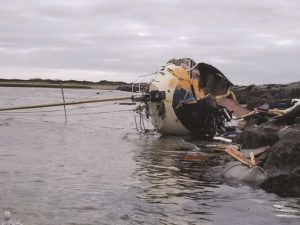The Provincetown waterfront once again took a severe beating from a coastal storm which, other than Hurricane Bob, was probably as intense as any coastal storm we’ve experienced in recent times. Wind gusts were predicted to be 50 to 60 m.p.h. from the northeast, and a storm warning flag flew above the harbormaster’s office, indicating anticipated winds of 48 to 63 knots.
What we got were winds more out of the east and gusts that New England Cable News said peaked at 97 m.p.h. David Ditacchio, a resident of Beach Point and former harbormaster, recorded a gust of 80 m.p.h. before his power went out. The easterly winds created unrelenting big waves that pummeled our harbor for hours on end.
Because water temperatures were running roughly 10 degrees warmer than normal for this time of year, the coastal low intensified rapidly here. Many boats that were still in the water were heavily damaged or sunk in what was essentially a Cat 1 hurricane without a name. The West End breakwater was littered with wreckage when the storm finally subsided enough for people to go out and assess the damage.
The guys at TowBoat U.S. did a fantastic job bringing up sunken boats and clearing the area so commercial fishing traffic could go safely in and out.

At the risk of repeating myself, this is climate change, creating warmer ocean water, more convection, consistently higher winds, and far more intense storms. And it is changing the dynamics of our harbor — which was barely a harbor of safe refuge even before.
Boats outside the east- and south-facing wave attenuators really have no protection from storms that generate east, southeast, and south winds and waves. Combine that with the fact that our harbor has a lot of deep water that can create large wind-driven waves quickly from those three directions, and you have a potentially catastrophic environment in such storms.
What is the answer? It is time for those of us who have boats and keep them in Provincetown to completely rethink what we do and how we do it.
Dock lines, mooring lines, and cleats on boats are not built to withstand the kind of pressure these hurricane-force winds and waves put on them. This is the primary reason boats break off their moorings or away from a dock.
We should also consider putting our boats in the water later in the spring and getting out of the water earlier in fall. And since our port does not have a marine travel lift, more of us need to go to Hyannis or East Dennis for that help when a storm is approaching.
Making slips or dockage available for boats outside the attenuators to get inside the attenuators in these situations would help a lot, too.



